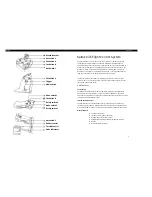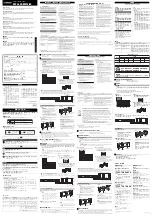
12 | SAMLEX AMERICA INC.
SECTION 3 |
BATTERY THEORY
• The battery with lower series resistance will take shorter time to charge
as compared to the battery which sees higher series resistance and
hence, will experience over charging and its life will be reduced.
• Life and capacity of the battery will be reduced.
3.3 Lead Acid Batteries
3.3.1 Battery Types
Sealed Lead Acid (SLA) or Valve regulated Lead Acid (VRLA) Batteries
Sealed Lead Acid (SLA) batteries or Valve Regulated Lead Acid (VRLA) batteries can either
be Gel Cell or AGM (Absorbed Glass Mat). In a Gel Cell battery, the electrolyte is in the
form of a gel. In AGM (Absorbed Glass Mat) battery, the electrolyte is soaked in Glass Mat.
In both these types, the electrolyte is immobile. There are no refill caps and the battery
is totally sealed. Hydrogen and Oxygen released during the charging process are not
allowed to escape and are recombined inside the battery. Hence, there is no water loss
and the batteries are maintenance free. These batteries have safety valves on each cell
to release excessive pressure that may be built up inside the cell. The Gel Cell is the least
affected by temperature extremes, storage at low state of charge and has a low rate of
self discharge. An AGM battery will handle overcharging slightly better than the Gel Cell.
Non Sealed (Vented / Flooded / Wet Cell) Lead Acid Batteries
In a non-sealed / vented / flooded / wet cell battery, each individual cell compartment
has a refill cap that is used to top up the cell with distilled water and to measure
the specific gravity of the electrolyte using a hydrometer. When fully charged, each
individual cell has a voltage of approximately 2.105V and electrolyte specific gravity
of 1.265. As the cell discharges, its voltage and specific gravity drop. Thus, a healthy,
fully charged, 12V nominal battery with each of the 6 cells fully charged to 2.105V
will measure a Standing Voltage of 12.63V at 25ºC / 77ºF. Also, in a healthy battery,
all the individual cells will have the same voltage and same specific gravity. If there is
a substantial difference in the voltages (0.2V or higher) and specific gravities of the
individual cells, the cells will require equalization.
SLI (Starting, Lighting, Ignition) Batteries
SLI batteries that are used for automotive starting, lighting, ignition and powering
vehicular accessories. SLI batteries are designed to produce high power in short bursts for
cranking. SLI batteries use lots of thin plates to maximize the surface area of the battery
for providing very large bursts of current (also specified as Cranking Amps). This allows
very high starting current but causes the plates to warp when the battery is cycled. Vehicle
starting typically discharges 1%-3% of a healthy SLI battery’s capacity. The automotive
SLI battery is not designed for repeated deep discharge where up to 80% of the battery
capacity is discharged and then recharged. If an SLI battery is used for this type of deep
discharge application, its useful service life will be drastically reduced.
This type of battery is not recommended for the storage of energy for DC powered
devices like lighting, radios, inverters, etc. However, they are recommended as
starting battery for the back-up generator.
Summary of Contents for EVO-30AB
Page 46: ...46 SAMLEX AMERICA INC Notes ...
Page 47: ...SAMLEX AMERICA INC 47 Notes ...













































